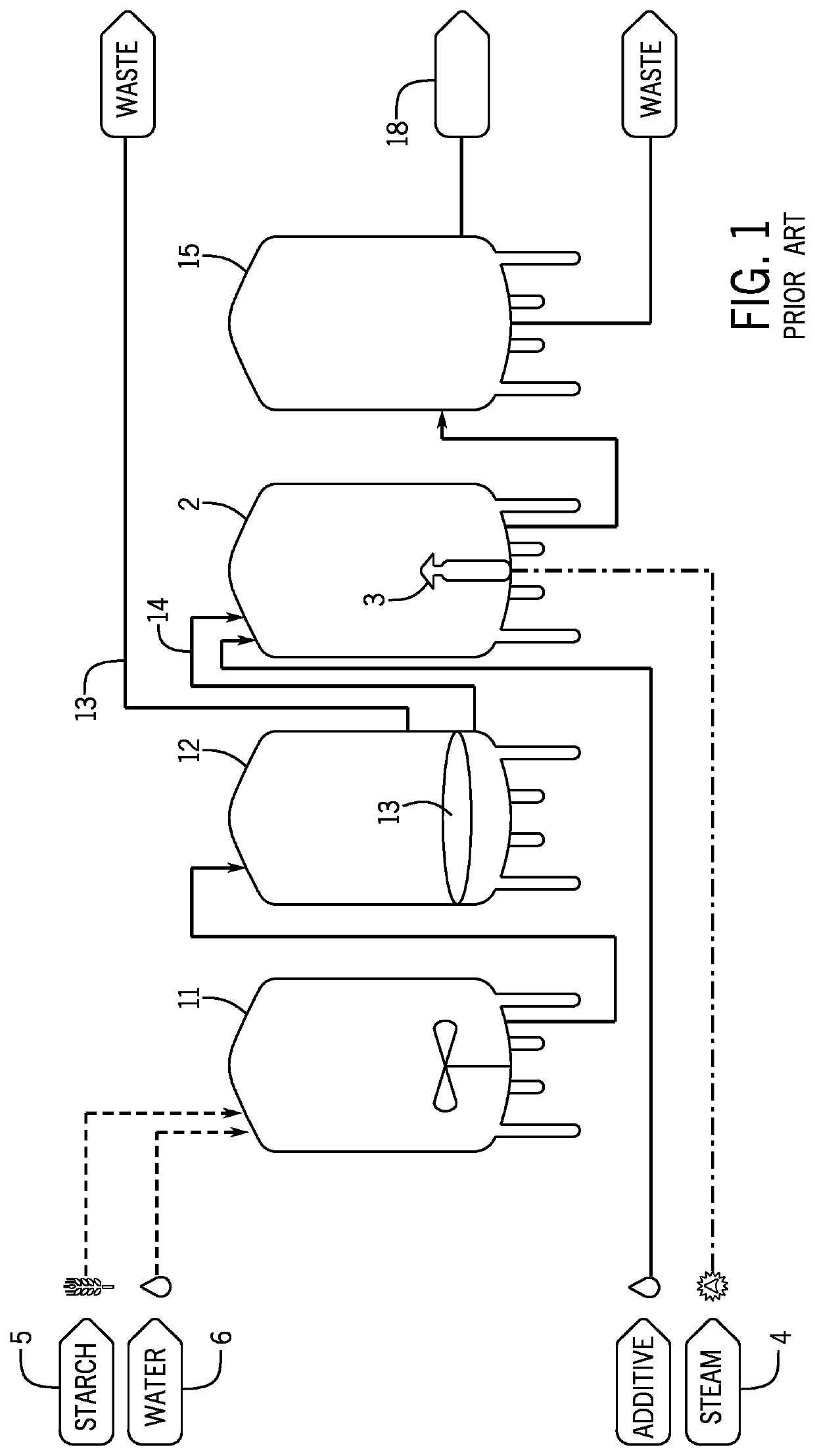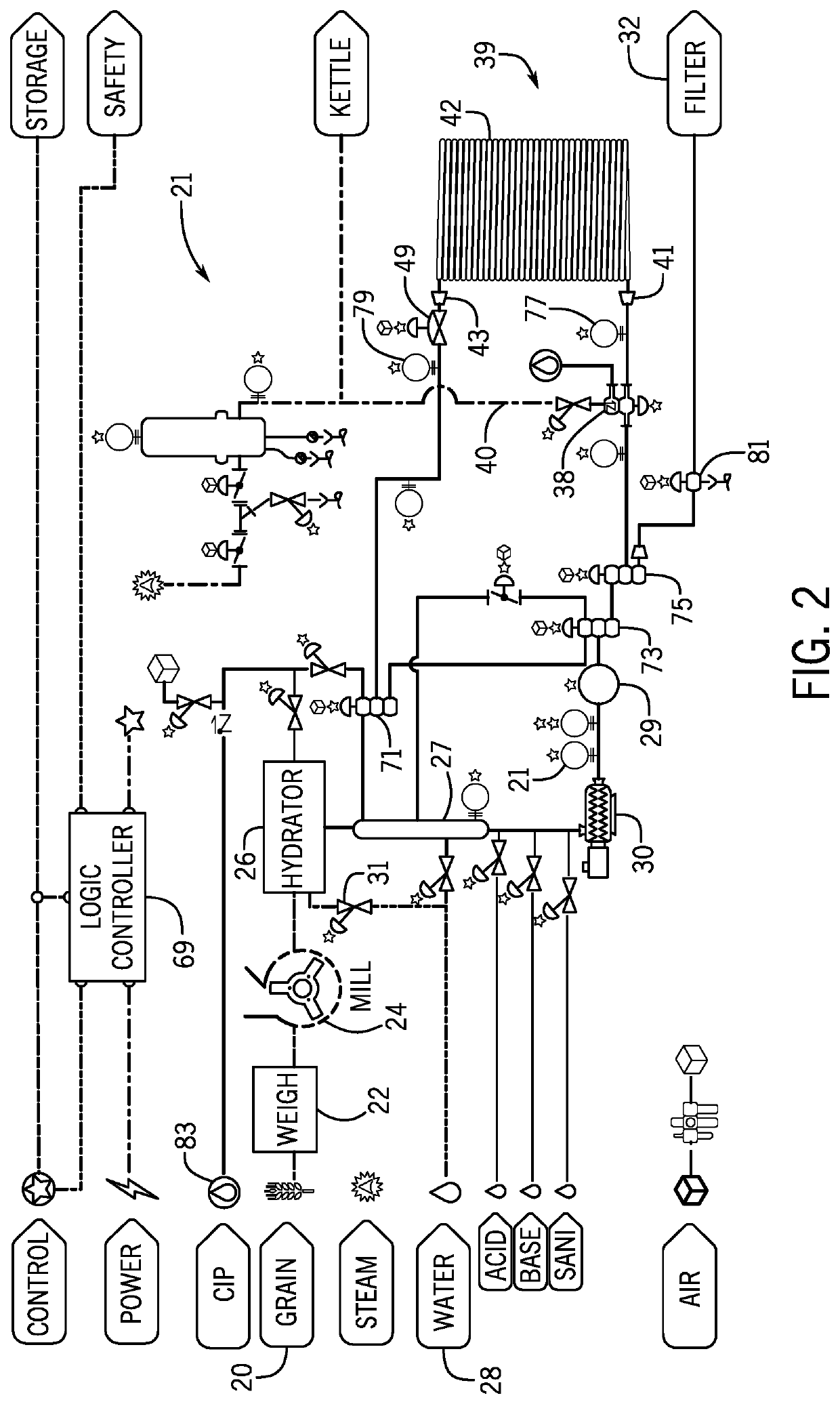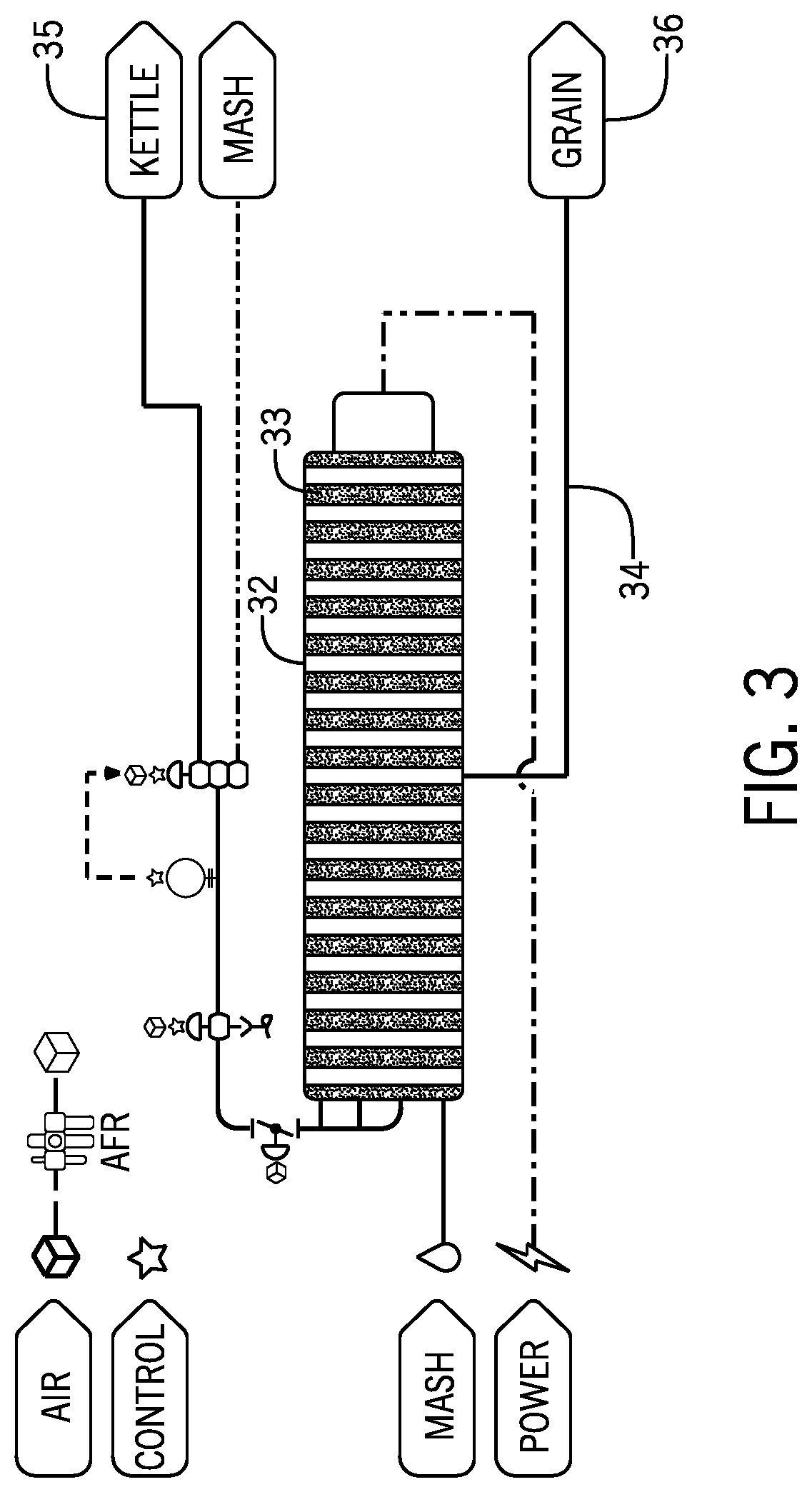The techniques and equipment used to generate these products are centuries old and advances in food production have not been applied successfully to the brewing industry.
Tanks slow production speeds due to inefficient heating, leading to long heating times, long enzymatic conversion times, and poor
temperature control.
Tanks also have no ability to repeatably control mash conditions optimal for enzymatic conversion, leading to batch to batch inconsistencies.
This consumes a large
footprint in the brewery and reduces the ability to add fermentors, which reduces annual beer production.
Additionally, due to the fast heating abilities, total extraction times are greatly reduced.
However, inherent to mash tuns is the inability to accurately create or hold temperatures of the entire mash throughout the
mashing phase.
Heating the mash in a tun creates hot and cold zones which yield batch-to-batch inconsistencies, requires high
horsepower agitated mixers which consume large amounts of energy, slows the extraction times due to slow heat stepping in multiple infusion mashes, and promotes dough balls which reduce batch efficiencies.
Boil kettles are traditionally slow to produce boiling temperatures after the influx of separated wort from the lauter tun or mash filter, typically only 75° C. to 78° C. This
lag time slows the brewing cycle and creates batch-to-batch inconsistencies.
Additionally, the traditional kettle is prone to boil-overs, which reduces efficiencies in wort yield, and creates batch-to-batch inconsistencies.
It is very difficult to achieve an exact strike temperature using this method, and it is common to be 3-7° C. away from the desired strike temperature.
Cold water blending is not exact, can change rapidly, and is difficult to automate due to the difference between winter water temperatures and summer water temperatures associated with the mixing water.
Because of this, it is common to introduce variability in the brewing process and unexpected delays due to the time it takes to get a mash to the correct temperature.
When using hot water, it is difficult to control the
mashing temperatures in the tank, often leading to significant temperature variation in the mash.
Additionally, heating using a jacket leads to product damage and increases heat-up time.
Both methods, often used in conjunction with each other, provide poor
temperature control in the mash itself.
Temperature is one of the most important parameters of effective enzymatic conversion and is the hardest to control.
Mixing and heating of the mash creates uneven temperature profiles.
The ability to hold temperature accuracy to less than 1° C. from
set point is currently not possible with traditional systems.
This will crack the individual kernels, which exposes the inner starchy
endosperm while still leaving the particles large.
As stated above, it is very difficult to achieve an exact temperature using this method, and it is common to be 3-7° C. away from the target strike temperature.
Ending below the strike temperature will not necessarily damage the wort, but it takes additional time to increase the temperature of the mash to the proper strike temperature, which can
delay the brewing process.
Additionally, heating quickly through tank jackets can damage the portion of the mash that is in contact with the tank walls.
Ending over the strike temperature causes bigger problems as there may be loss of enzymatic activity and the possibility to extract tannins from the grain husks, which significantly reduces the quality of the finished beer.
Additionally, the only way to cool down the mash is mix in cold water, which is not only a slow and inaccurate process, but waters down the mash.
If the brewer is using 100% water in the mash tun in their process, then the final wort will not meet quality specifications.
Moreover, mash tuns are not be able to accurately control the exact temperature of the mash at all points, which means that the
temperature gradient can never be repeated.
This adds batch-to-batch inconsistency to the brewing process.
This creates dough balls (also known as fisheyes) that cause
processing problems, as no enzymatic conversion of starches happens in unwetted grains.
This can negatively affect the
sugar yield of the final mash and most certainly slows down the process.
This process is very slow, allows the wort to lose heat, and can “stick”.
This reduces the quantity of wort reclaimed, and increases the time it takes to achieve a boil in the kettle.
However, it still utilizes a tun which will:Temperature gradients reduce repeatabilityIncreases cleaning times and chemical usageStill relies on lautering for solids removalStill produces 75%-85% mash efficienciesTake large amount of floor space
These methods all heat through a
metal surface, or plate, such that the surface temperature of the
metal plate is anywhere from 130° C. to 170° C. One of the main flaws of this method of boiling is that the lowest velocity area of the wort is at the heated surface.
This creates
residence time of the wort at the point of greatest heat, and in turn generates burn-on and
caramelization of the wort.
The major cause of burn-on is the
Maillard reaction, which binds proteins in the wort to sugars and this compound deposits on the
piping or tanks walls.
These deposits reduce the
heating efficiency of the apparatus by insulating the heating surface, and create a cleaning problem with the residual
surface film.
Other limitations of current methods are seen in the inability to heat the wort over boiling temperatures.
Calandrias must also be pressurized to achieve this over temperature, but can be erratic due to foaming.
Additionally, kettles must be sized and rated for the steam consumption needs to deliver these temperatures, which drive their size and cost up, but their efficiencies down.
Additionally, the current methods have a long
lag time.
Very commonly,
lag times of 15 to 30 minutes are needed to reach the desired temperature, which creates added time in the brewing process.
This yields a variable amount batch to batch, for boiling time, which impacts the consistency of the generated wort.
When boiling, wort foam is a
processing problem because it forms at a faster rate than it breaks down.
Additionally, when hops are first introduced into the boiling wort, the hops tend to float, so boil-overs during this phase reduce hop concentrations that can affect the qualities of the finished beer.
This method is not always effective at controlling boil-overs as foam hardiness changes as the boil progresses.
Additionally, if the brewer fills the boils kettle to a volume over the china cap, this method is ineffective as a means of controlling foam.
The spray action with cold water is an effective means to control the foam, but adds a variable and undetermined amount of water to the
recipe.
This variability causes batch-to-batch inconsistency and changes the mineral concentration of the beer, which can affect the qualities of the finished beer.
Additionally, this method cools down the wort, which can take time to regain a vigorous boil.
This problem is exacerbated when used in conjunction with boiling methods where temperatures over 100° C. are achieved.
This method creates an excess amount of foam, requiring additional foam suppression methods.
This solution is integrated into the top of the kettle, so the
specific volume of wort in the kettle does not reduce its effectiveness, as it does with current designs.
This is inherently due to steam condensate being consumed into the heated process.
Though it is energy efficient on the product heating side, it creates a boiler
energy recovery problem on the utility side.
The more steam that is required to preheat the feed water, the less efficient the entire
energy balance of the boiler system becomes.
 Login to View More
Login to View More 


